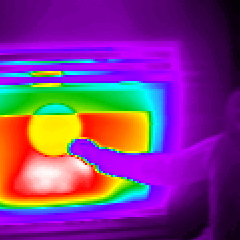There are two IR images on this page which show why the distinction between radiosity and emissive power is so important for evaluating infrared data. Figure 1 shows my cat, Oliver Heaviside, with his back to the fireplace. We all know how cats love warmth, but if you refer to the temperature scale for the colors in this image, poor Oliver is 53°C at the warmest part of his back. This is very hot. How can Oliver withstand such temperatures?

 Oliver in his favorite spot. Fig. 1.
Oliver in his favorite spot. Fig. 1.
The answer is that Oliver is not this warm. The camera makes the image by assuming that the objects in view supply all of the power that its sensor detects. In other words it assumes that the detected radiation comes from emissive power, and, using a value of 1.0 for emissivity of these objects, it calculates equivalent temperatures using Stefan's Law.
Oliver, despite being a black cat, is not a perfect black cat. His fur is shiny and will reflect radiation. He is reflecting some of the emitted power of the fire without absorbing it. A supporting clue to this is that the cardboard box just to the right of Oliver shows a very hot seam on its open lid. Once again, this is not hot. The seam happens to be oriented so that it reflects emitted power from the fire directly into the camera.
What the camera measures is actually radiosity, radiation coming from an object without regard to whether the object emitted that power or merely reflected it.
Figure 2 shows someone holding a 200mm diameter silicon wafer in front of the fire. The highest temperature in the fireplace is about 250°C. The wafer is actually cold to the touch, but the camera has recorded it as being more than hot enough to boil water. How can the woman stand to hold this wafer with her bare hand?
 Figure 2. A silicon wafer before the fire!
Figure 2. A silicon wafer before the fire!

Once again, the answer is that the camera records radiosity. Silicon is transparent to infrared radiation. This wafer is only 750microns thick and transmits much of the emitted power from the fire. It obviously absorbs some of the radiation, because it displays a sudden drop in emitted power at the wafer's edge. However, most of the radiosity recorded here is actually that of the fire. Note the strange pattern of radiation from the wafer that matches the pattern of temperature from the fireplace.
If I had left the wafer in front of the fire long enough, it would have absorbed radiation and become quite hot. It would have appeared more nearly like the temperature of the background.